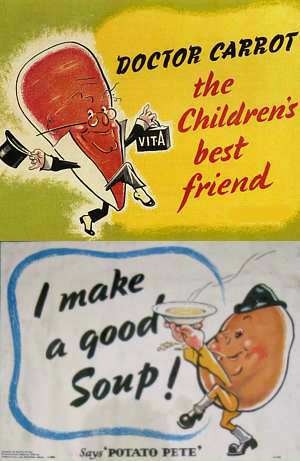This leaflet on National Growmore Fertilizer from November 1942 was sadly damaged and some information lost. However it was repeated near word for word in the January Monthly Guide for 1945 so the gaps have been filled in.
It should be remembered that a lot of new land was being brought into food production and most of it was poor quality and nutrient deficient. It required some fertilizer to bring it into immediate production. National Growmore Fertilizer which is still commonly available today as Growmore was a sensible, pragmatic reaction.
Testing for nutrient levels on small plots was impractical as the tests were complex and required a laboratory (in the 1940s). Providing a basic mix of the ‘big three’ nutrients covered the majority of requirements. Standardisation of product reduced costs and made it easier to advise how much to use.
In the days before advertising standards all sorts of claims were made for a variety of fertilisers – some were good and others not so. All the new growers needed, above all, simplicity and consistency.
NATIONAL GROWMORE FERTILIZER
To meet the needs of those who are growing vegetables on an allotment or in private gardens, the Government has arranged for the supply of a good standard fertilizer at a reasonable price.
It is called “National Growmore Fertilizer ” and contains the three important plant foods – nitrogen, potash and phosphates, the analysis being 7 per cent. N, 7 per cent. P2O5 and 7 per cent. K2O.
On most soils, 42 Ib. of National Growmore Fertilizer should be enough for a 10-rod plot (300 square yards).
As land becomes free of crops it should be dug and got ready for another crop. Just before sowing or planting, scatter 1 Ib. evenly over every 10 sq. yards and rake in. To give this general dressing to a 10-rod allotment will take 30 lb.
This will leave 12 Ib. for giving an extra dressing to potatoes, winter green crops and spring cabbages. 4½ Ib. should be reserved for potatoes and should be applied at planting time. After the potatoes have been set out in the drills a little soil should be scuffled over them, the fertilizer scattered on top of this soil at the rate of ½ lb. Per 30 ft., and the drills filled in completely.
If you are following the allotment cropping plan contained in Dig for Victory Leaflet No. 1, the 4½ Ib. of fertilizer would be applied to 9 rows of potatoes, the rate, therefore, being ½ Ib. for each 30 foot row
5½ lb should be kept for applying during August to the winter green crops when they need it during the growing season. The 2 Ib. left should be used during March as a top dressing for spring cabbage.
On some allotments or in some gardens it may be necessary to give an additional top dressing of a nitrogenous fertilizer (such as sulphate of ammonia) during the growing season to any crops that may need it.
Sulphate of ammonia should be applied about 1 !b. per 10 square yards.
You will be able to get National Growmore Fertilizer from most sundries merchants. Allotment societies and similar bodies, which have hitherto bought their fertilizers in bulk, will be able to buy National Growmore Fertilizer in bulk at reduced prices.
GROWMORE BULLETINS
for the ALLOTMENT HOLDER AND GARDENER
No. 1 Food from the Garden, 3d. net. (4d. by post).
No. 2 Pests and Diseases in the Vegetable Garden, 4d. net. (5d. by post).
No. 3 Preserves from the Garden, 4d. net. (5d. by post).
No. 7 Fruit from the Garden, 3d. net. (4d. by post).
Obtainable from
H.M. Stationery Office, York House, Klngsway, London, W.C.2,
or through a bookseller.
ISSUED BY THE MINISTRY OF AGRICULTURE



